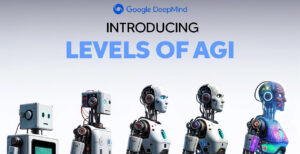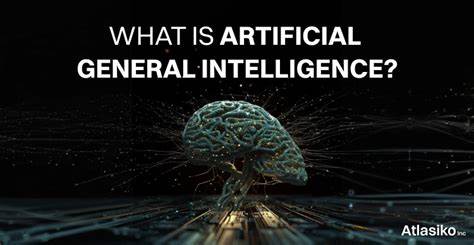Artificial General Intelligence (AGI): Definition, Key Features, Examples & Challenges

Artificial General Intelligence (AGI) is the next frontier in artificial intelligence development — a form of AI that can understand, learn, and solve problems with human-like versatility across a wide range of tasks. Unlike narrow AI, which excels only at specific functions such as image recognition or language translation, AGI aims to replicate the flexible and adaptive intelligence of the human brain. This breakthrough could revolutionize industries, reshape economies, and redefine our interaction with technology.
What is Artificial General Intelligence (AGI)?

AGI refers to an AI system capable of performing any intellectual task that a human being can do. It goes beyond specialized AI by demonstrating:
-
Versatility across multiple domains
-
Adaptability to new and unfamiliar situations
-
Self-improvement without human intervention
-
General understanding of complex concepts
In essence, AGI mimics human cognitive abilities — from creative thinking and emotional understanding to physical interaction and social engagement.
Key Characteristics of AGI

1. Versatility Across Tasks
AGI can seamlessly switch between diverse activities — from playing chess and composing music to interpreting human emotions and conducting scientific research.
2. Adaptability
Learning from experience, AGI adjusts its behavior and strategies to solve new challenges without predefined programming.
3. Self-Improvement
AGI has the potential to autonomously identify its own limitations and innovate methods to enhance its own performance.
4. General Understanding
Unlike narrow AI, AGI processes information flexibly across contexts, making decisions with a human-like understanding of the world.
What Does AI Need to Become AGI?

Achieving true AGI requires progress in several fundamental areas:
-
Visual Perception: Ability to understand and interact with real-world environments, recognizing subtle cues and contextual details.
-
Audio Perception: Processing speech with nuance—understanding tone, intent, and filtering background noise.
-
Fine Motor Skills: Executing precise and adaptive physical movements to interact effectively with objects and surroundings.
-
Natural Language Processing (NLP): Advanced comprehension and generation of human language, capable of handling complex dialogue.
-
Problem Solving: Creative and flexible approaches to new problems, adapting strategies to evolving situations.
-
Navigation: Mastery of dynamic environments for safe and efficient movement.
-
Creativity: Generating novel ideas and solutions beyond pre-learned data.
-
Social & Emotional Intelligence: Understanding and responding appropriately to human emotions for meaningful interaction.
Challenges Facing AGI Development

Despite technological strides, several obstacles remain:
-
Common Sense Reasoning: Machines struggle with everyday reasoning that humans perform intuitively.
-
Transfer Learning: Applying knowledge learned in one domain to different, unrelated tasks remains difficult.
-
Interpretability: Ensuring AGI’s decisions are transparent and explainable to build trust and ensure safety.
-
Ethical Considerations: Balancing innovation with social responsibility, including privacy, fairness, and bias mitigation.
-
Security Risks: Protecting AGI systems from misuse, cyber threats, and unintended consequences.
-
Existential Risks: Managing the potential for superintelligent AI to act beyond human control.
Real-World Examples of AGI-Like Systems
While true AGI is still in development, some AI systems today demonstrate foundational AGI traits:
Personal Assistants
Voice-activated assistants like Siri, Alexa, and Google Assistant can interpret natural language, perform multiple tasks, and adapt to user preferences, hinting at future AGI capabilities.
Self-Driving Cars
Autonomous vehicles process vast sensor data in real-time, making complex decisions to navigate unpredictable environments—showcasing perception, problem-solving, and adaptability.
Healthcare Virtual Assistants
AI-driven healthcare assistants analyze patient data, understand medical queries, and support personalized treatment plans, blending domain expertise with natural language understanding.
Creative AI in Art and Music
Generative AI models create paintings, music, and literature, displaying originality and creativity once thought exclusive to humans.
General Game Playing AI
Programs like AlphaGo demonstrate strategic thinking across various games, learning and adapting tactics that resemble human intelligence.
Implementing AGI: Current Approaches and Future Directions
Developing AGI involves combining multiple AI disciplines:
-
Integrative Architectures: Combining vision, language, motor control, and reasoning modules into unified systems.
-
Continuous Learning: Building models that improve over time from diverse data sources and experiences.
-
Human-AI Collaboration: Creating interfaces for smooth interaction and oversight, ensuring AGI complements human abilities.
-
Robust Safety Protocols: Embedding ethical guidelines and fail-safes to manage risks.
Investment in research, cross-disciplinary collaboration, and ethical frameworks will guide AGI development towards beneficial applications.
Conclusion: The Promise and Responsibility of AGI
Artificial General Intelligence holds the promise to transform how we live, work, and solve global challenges. From boosting innovation to automating complex tasks, AGI can unlock unprecedented opportunities. However, its emergence also calls for careful consideration of ethical, social, and security impacts to ensure that AGI serves humanity’s best interests.
By understanding AGI’s key features, challenges, and potential applications, we prepare ourselves for a future where human and artificial intelligence advance together.
Also Read:
Google Unveils Veo 3: The Future of AI-Generated Video Is Here


Leave a Reply